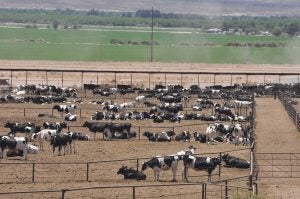Methane. The principal component of natural gas. One atom of carbon and four atoms of hydrogen (CH4). I know you’re getting tired of hearing how bad it is compared to carbon dioxide as a greenhouse gas, and that cattle are one of the main sources. I know I have written about global warming and agriculture’s purported contribution to it a couple of times in the recent past, but it is going to get a lot of emphasis with the Biden administration, so a few points should be clarified and repeated.
In the first place, the grass and grain cattle eat take carbon dioxide out of the air. In the rumen, methanogens feed on the fermentation product of plants the cow has eaten and release some of the carbon consumed by the cow as methane. Methane released to the atmosphere in “cow burps” will decay back into carbon dioxide within 10 to 12 years. This is a cycle that has been going on since ruminants have occupied their niche on Earth, so the amount of methane in the atmosphere from ruminants (cattle for food, cattle for draft animals, sheep, goats, bison, deer, elk, antelope, etc.) has not changed that much in thousands of years.
Secondly, cattle’s methane impact in the U. S. is getting less because of gains in efficiency of producing beef and milk, according to data from the U.S. Department of Agriculture. In 1970, 12.5 million milk cows produced 117.4 million pounds of milk. In 2019, 9.3 million cows produced 218.4 million pounds — 86 percent more milk from 26 percent less cows. Since 2000, milk production per cow has risen 28 percent and the dairy industry now produces 30 percent more milk on slightly more cows. Beef cattle numbers are down six percent since 1970, but meat production from those cattle is up 25 percent, partly due to heavier weight at slaughter, made possible by breeding animals to deliver higher growth rates and higher feed efficiencies. These efficiency trends will continue. Expect breakthroughs in feed additives that will increase feed efficiency by suppressing CH4 production by methanogens in the rumen.
Energy not used by the methanogens would then be available for animal growth or milk production.

Expect activists to lobby the Biden administration to break up large dairies and feeding operations, and get more cattle on pasture. President Eisenhower once said, “It’s easy to farm when your plow is a pencil and you’re 1,000 miles from the cornfield.” Activists and bureaucratic pencil pushers who advocate putting more cattle on pastures to reduce greenhouse gas emissions are too far from the cornfield. Cattle on pasture emit more methane for several reasons:
- Feeding grain to cattle suppresses methanogens in the rumen. Fattening cattle on grass only means more food to ferment in the rumen and more methane emitted per unit of weight gain.
- It takes longer to get them to slaughter weight, so more days to belch.
- Activists say dropping manure on pastures reduces emissions, but the opposite is the reality. Fresh manure will generally contain about 12 pounds of nitrogen per ton. Manure dropped on a pasture will lose 40 to 60 percent of the nitrogen to the atmosphere. Gathered daily and put in a covered lagoon can reduce losses to 15 percent. Methane produced in the lagoon can then be burned to generate electricity for a dairy or feedlot.
Why is methane so bad anyway? Compared to carbon dioxide, it is a miniscule gas in the atmosphere (413ppm vs 1.7ppm, or 0.041% vs 0.00017%). Climatologists claim its warming potential is about 80 times that of CO2 over a 20-year period. The details are in what infrared holes it plugs. Water vapor is by far the most abundant heat absorbing molecule in the atmosphere, and for us, that’s a good thing. Without something to retain the heat from the sun the earth would be very cold, as Mars is today. On the other hand, if some of the heat didn’t escape to space, earth could be too hot for life, like Venus.
When visible light waves from the sun strike the earth, some is reflected back to space from white surfaces such as snow, ice, or clouds. Most of it is absorbed by the soil, rocks, vegetation, etc. These objects reradiate the energy in waves of infrared heat, which we can feel but not see. These waves are longer than light waves, and are more easily trapped by water vapor, carbon dioxide, methane, and other gasses. These gasses reradiate the heat in all directions, with some escaping to space and some bouncing back to Earth.
A problem arises when too much of the infrared is reflected back to Earth. Water vapor does not absorb all wavelengths in the infrared. (Infrared waves range in length from one billionth of a meter to one thousandth of a meter.) So some waves get an unhindered path back to space. This is where greenhouse gasses get involved: They plug holes water vapor leaves open. Carbon dioxide plugs a lot of the same holes water vapor does, but also some water vapor doesn’t plug. Methane plugs holes neither carbon dioxide nor water vapor plugs, which makes it particularly effective as a greenhouse gas.
Worldwide, cattle are not the major source of methane, and as I stated in the beginning, methane from cattle starts out as carbon dioxide in the atmosphere and eventually recycles back to atmospheric carbon dioxide. The biggest source is the oil, natural gas and coal industries (19 percent). Ruminants are said to account for 16 percent of emissions. Sewage treatment and animal waste each contribute 5 percent. Rice cultivation accounts for 12 percent of emissions, as methanogens do well in the water-logged soils where oxygen levels are suppressed. Landfills and biomass burning account for 14 percent. Termites emit 4 percent, and wetlands and other natural sources amount to 25 percent.
If the incoming administration wants to pay farmers to store carbon, I think that would be great. And I hope they realize that U.S. Environmental Protection Agency’s own data assigns 9 percent of U.S. greenhouse gas emissions (GHG) to agriculture, and credits agriculture and forestry with offsetting 11 percent of U.S. GHG emissions, sinking CO2 into soil organic matter and plant tissue. A net positive for agriculture and forestry of 2 percent.
Jack DeWitt is a farmer-agronomist with farming experience that spans the decades since the end of horse farming to the age of GPS and precision farming. He recounts all and predicts how we can have a future world with abundant food in his book “World Food Unlimited.” A version of this article was republished from Agri-Times Northwest with permission.



